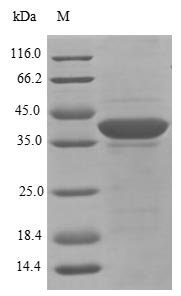Recombinant Rat Eukaryotic translation initiation factor 3 subunit I (Eif3i) is produced in E. coli and represents the complete protein sequence from amino acids 1-325. The protein carries an N-terminal 6xHis tag, which makes purification and detection more straightforward. SDS-PAGE analysis confirms purity levels above 85%, suggesting this protein should work well for research applications that demand high-quality samples.
Eukaryotic translation initiation factor 3 subunit I (Eif3i) appears to be an integral component of the eIF3 complex, which seems critical during the early stages of protein synthesis. Within this complex, Eif3i likely helps coordinate the assembly of the 40S ribosomal subunit with messenger RNA and various initiation factors. This process may influence how cells regulate translation initiation and control overall protein production.
Potential Applications
Note: The applications listed below are based on what we know about this protein's biological functions, published research, and experience from experts in the field. However, we haven't fully tested all of these applications ourselves yet. We'd recommend running some preliminary tests first to make sure they work for your specific research goals.
Eif3i is a subunit of the eukaryotic translation initiation factor 3 (EIF3) complex, which requires proper folding and assembly with other subunits for biological activity. E. coli, as a prokaryotic expression system, lacks the chaperones and post-translational modifications needed for the correct folding of many eukaryotic proteins. While the His tag may improve solubility, Eif3i likely requires specific interactions within the multi-subunit EIF3 complex for native conformation. Without experimental validation (e.g., circular dichroism for secondary structure or functional assays), it is uncertain whether the protein is correctly folded or bioactive. The 85% purity also suggests potential impurities or misfolded aggregates. Therefore, the protein may not be correctly folded or functional, and verification is essential before functional applications.
1. Protein-Protein Interaction Studies for Translation Initiation Complex Assembly
If the recombinant Eif3i is verified to be correctly folded (e.g., through biophysical assays), it could be used in pull-down or co-immunoprecipitation experiments to study interactions with other EIF3 subunits or ribosomal components. The His tag facilitates immobilization for binding assays. However, if the protein is misfolded, interaction results may be unreliable due to non-specific binding or altered binding sites. Validation with a native EIF3 complex from eukaryotic sources is recommended to confirm physiological relevance.
2. Antibody Development and Validation
This recombinant Eif3i can be used as an antigen for antibody production, as antibodies often recognize linear epitopes even in misfolded proteins. The high purity and full-length sequence make it suitable for immunization. However, antibodies generated might not bind to native, correctly folded Eif3i in physiological contexts. The His tag could induce non-specific antibodies, so tag removal or control experiments are advised. Antibodies should be validated against eukaryotic-expressed Eif3i to ensure specificity for Western blot, immunoprecipitation, or immunofluorescence.
3. Biochemical Characterization and Structural Studies
The protein is suitable for preliminary biophysical characterization (e.g., dynamic light scattering for aggregation analysis, circular dichroism for secondary structure) to assess folding status. However, correct folding is essential for detailed structural studies (e.g., X-ray crystallography or NMR). A misfolded protein may not yield meaningful data. The His tag simplifies purification, but may interfere with crystallization. If misfolding is confirmed, the protein can still be used for misfolding studies or as a control, but not for high-resolution structure determination.
4. In Vitro Translation Assay Development
If the recombinant Eif3i is bioactive (verified through functional assays, such as complementation in EIF3-depleted systems), it could be added to cell-free translation systems to study its role in initiation. However, if misfolded or inactive, it may not restore translation activity, leading to false negatives. The protein should first be tested in reconstitution experiments with other EIF3 subunits to confirm functionality. Comparisons with homologs from other species require active protein.
Final Recommendation & Action Plan
Before using this recombinant Eif3i protein for any functional application, it is crucial to validate its folding and bioactivity. Start with basic biophysical assays (e.g., circular dichroism to check for expected secondary structure, size-exclusion chromatography to monitor oligomerization and purity) to assess folding status. Then, perform functional assays, such as testing its ability to integrate into EIF3 complexes or restore translation in depleted systems. If activity is confirmed, proceed with interaction or structural studies; otherwise, limit use to non-functional applications like antibody production, but always validate outcomes with native protein.






